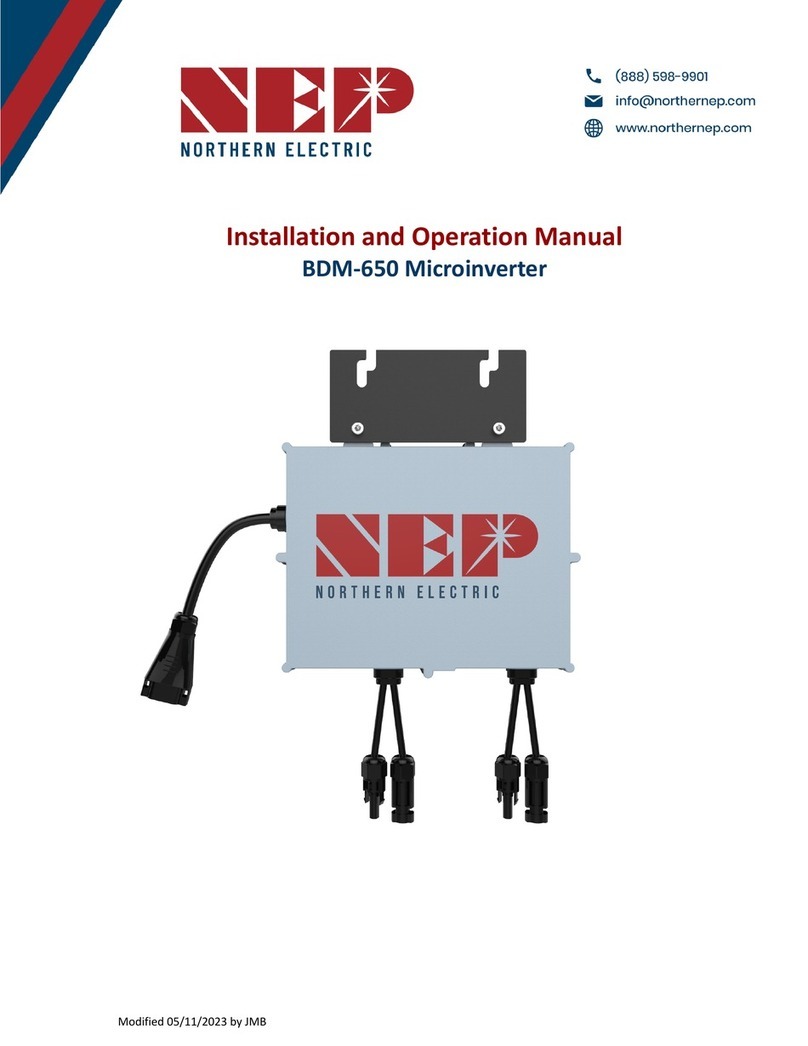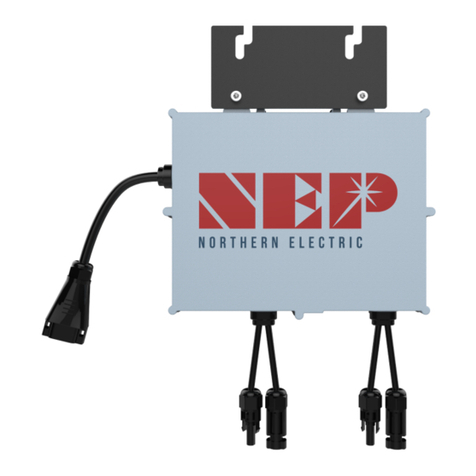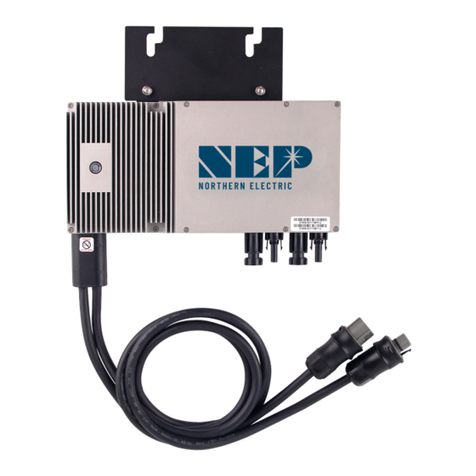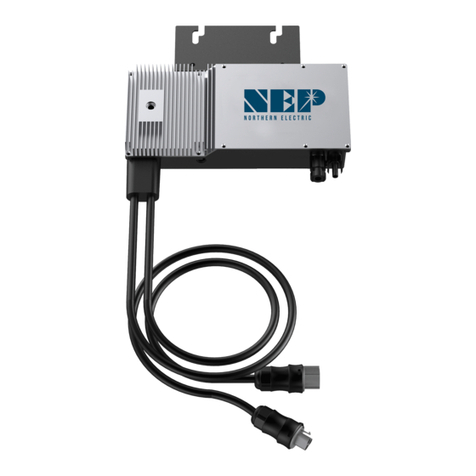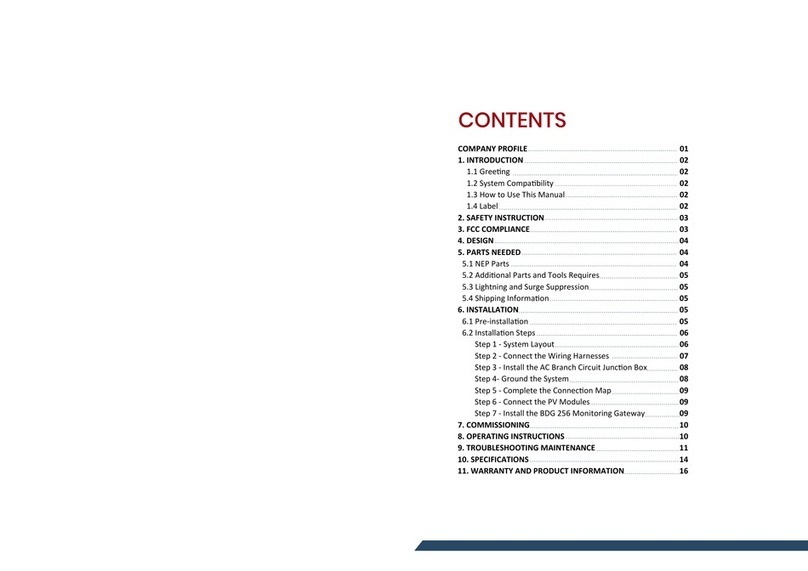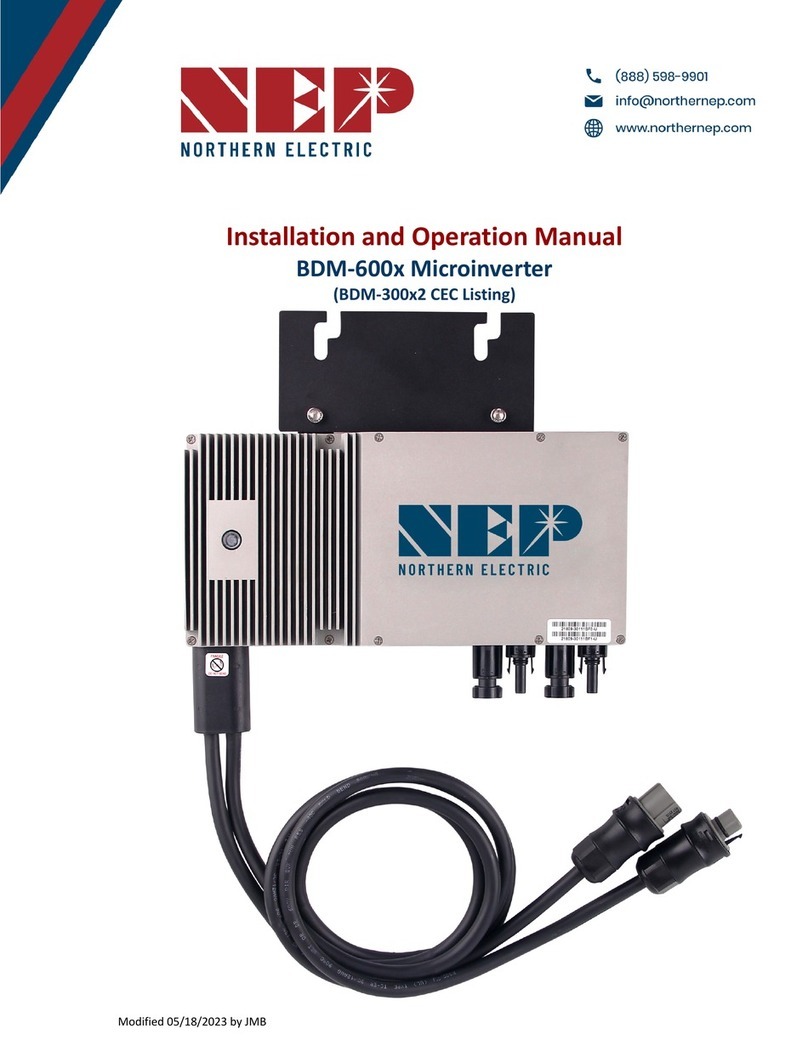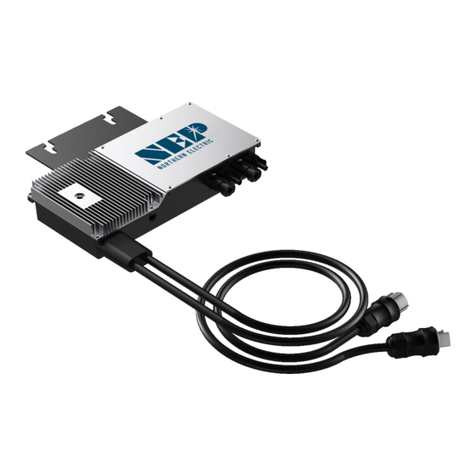NEP BDM-300 User manual

Installation and Operation Manual
BDM-300/400 Microinverter
Modified 04/13/2023 by JMB
1

Contents
Contents-------------------------------------------------------------------------------------------------------------------------------------------------- 2
COMPANY PROFILE------------------------------------------------------------------------------------------------------------------------------ 4
1. INTRODUCTION------------------------------------------------------------------------------------------------------------------------------- 5
1.1 Prefix-------------------------------------------------------------------------------------------------------------------------------------5
1.2 Standards Compliance---------------------------------------------------------------------------------------------------------------5
1.3 How to Use This Manual------------------------------------------------------------------------------------------------------------ 5
1.4 Label------------------------------------------------------------------------------------------------------------------------------------- 5
2. SAFETY INSTRUCTION------------------------------------------------------------------------------------------------------------------------6
3. FCC COMPLIANCE-----------------------------------------------------------------------------------------------------------------------------7
4. INSTALLATION----------------------------------------------------------------------------------------------------------------------------------8
4.1 Parts Included------------------------------------------------------------------------------------------------------------------------- 8
4.2 Other Parts and Tools Required--------------------------------------------------------------------------------------------------- 8
4.3 Lightning Surge Suppression------------------------------------------------------------------------------------------------------- 9
4.4 Installation Procedure--------------------------------------------------------------------------------------------------------------- 9
4. 5 Install the AC Branch Circuit Junction Box------------------------------------------------------------------------------------10
4.6 Mounting------------------------------------------------------------------------------------------------------------------------------11
4.6.A Attach BDM-300/400 to the Racking--------------------------------------------------------------------------------- 11
4.6.B Attach BDM-300/400 to the Frame------------------------------------------------------------------------------------11
4.7 Connect the BDM-300/400 Wiring Harnesses------------------------------------------------------------------------------- 12
4.8 Ground the System----------------------------------------------------------------------------------------------------------------- 13
4.8A Through Trunk Cable-------------------------------------------------------------------------------------------------------13
4.8.B Through Racking----------------------------------------------------------------------------------------------------------- 13
5. Commissioning-------------------------------------------------------------------------------------------------------------------------------14
5.1 Commissioning Steps---------------------------------------------------------------------------------------------------------------14
5.2 Inverter/RSD Serial Input----------------------------------------------------------------------------------------------------------15
5.2.A Manually on Device------------------------------------------------------------------------------------------------------- 15
5.2.B Using USB Barcode Scanner--------------------------------------------------------------------------------------------- 15
5.2.C Using Web Browser--------------------------------------------------------------------------------------------------------15
5.3 Installer Registration--------------------------------------------------------------------------------------------------------------- 16
5.4 Homeowner Registration----------------------------------------------------------------------------------------------------------17
5.5 Pre-Commissioning Setup---------------------------------------------------------------------------------------------------------17
5.6 Create a Site on NEP Website---------------------------------------------------------------------------------------------------- 17
5.7 Verify and Map Site-----------------------------------------------------------------------------------------------------------------18
6.6 Commission the Gateway and Confirm Site Setup-------------------------------------------------------------------------- 19
6.7 Grant Homeowner Access to Module View (Optional)-------------------------------------------------------------------- 19
7. Operating Instructions--------------------------------------------------------------------------------------------------------------------- 19
Modified 04/13/2023 by JMB
2

7.1 Status: Standby---------------------------------------------------------------------------------------------------------------------- 19
7.2 Producing Power-------------------------------------------------------------------------------------------------------------------- 19
7.3 Grounding Fault--------------------------------------------------------------------------------------------------------------------- 19
8. TROUBLESHOOTING AND MAINTENANCE-------------------------------------------------------------------------------------------- 20
8.1 LED Indication of Error------------------------------------------------------------------------------------------------------------- 20
8.1.C Error Mode (except for grounding error)-----------------------------------------------------------------------------20
8.1.B NOT communicating with BDG-256, and with no error-----------------------------------------------------------20
8.1.C Grounding Fault------------------------------------------------------------------------------------------------------------ 21
8.2 Troubleshooting An Inoperable BDM-300/400/400------------------------------------------------------------------------ 21
8.3 Disconnecting a BDM-300/400 from the PV Module-----------------------------------------------------------------------21
8.4 Installing a Replacement BDM-300/400---------------------------------------------------------------------------------------21
9. Data Sheets----------------------------------------------------------------------------------------------------------------------------------- 22
9.1 BDM-300------------------------------------------------------------------------------------------------------------------------------ 22
9.2 BDM-400------------------------------------------------------------------------------------------------------------------------------ 23
11. WARRANTY AND PRODUCTION INFORMATION------------------------------------------------------------------------------------ 24
What does this warranty cover and how long does it last?--------------------------------------------------------------------24
What will NEP do?----------------------------------------------------------------------------------------------------------------------- 24
How do you get service?--------------------------------------------------------------------------------------------------------------- 25
What does this warranty not cover?------------------------------------------------------------------------------------------------ 25
Disclaimer Product-----------------------------------------------------------------------------------------------------------------------25
Modified 04/13/2023 by JMB
3

COMPANY PROFILE
Northern Electric Power Technology Inc. (NEP) is a U.S.-based company with manufacturing and
R&D facilities in Asia. Our mission is to develop cutting-edge clean energy technologies and provide
state-of-the-art solar inverter, rapid shutdown, and monitoring products to our customers.
Our headquarters are located in Tsingtao, a major industrial center and trading port in
northeastern China. Our campus occupies over 18 acres in the Tsingtao Export Processing Zone,
with more than 650,000 square feet of building space. We plan to connect our campus through a
micro smart grid demo community, powered by solar, wind, and micro turbines. In addition to our
headquarters, we have operation offices Pleasonton, USA.
Our founders are well-known experts in the fields of power electronics, automatic control, signal
processing, and communications. Each of our founders has multiple U.S. and world patents in their
specialty areas, and received Ph.D. degrees from top universities in North America. They each have
over 10 years of engineering and management experience in leading U.S. companies.
NEP offers a complete product line of grid-tied solar inverters, including micro inverters ranging
from 180W to 2000W, and industry leading Rapid Shutdown Devices (RSD). Our field deployment
results have demonstrated the high efficiency and reliability of NEP solar inverters.
At NEP, we are committed to developing Clean, Reliable, Affordable, and Efficient products for our
customers worldwide.
Modified 04/13/2023 by JMB
4

1. INTRODUCTION
1.1 Prefix
We hope that our products will meet your needs for renewable energy. We highly value your feedback regarding our
products and would greatly appreciate any comments you may have.
Thank you for your business, and please do not hesitate to contact us if you have any questions or concerns.
1.2 Standards Compliance
The BDM-300/400 complies with the NEC 2014 and NEC 2017 article 690.12, and CEC 2015 section 64-218.
1.3 How to Use This Manual
This manual provides detailed product information and installation instructions for the BDM-300/400. Please read
through this manual before installation and operation.
WARNING: This indicates a situation where failure to follow instructions may be a safety hazard or cause
equipment malfunction. Use extreme caution and follow
instructions carefully.
1.4 Label
Modified 04/13/2023 by JMB
5
Other manuals for BDM-300
1
This manual suits for next models
1
Table of contents
Other NEP Inverter manuals
Popular Inverter manuals by other brands

BARRON
BARRON EXITRONIX Tucson Micro Series installation instructions

Baumer
Baumer HUBNER TDP 0,2 Series Mounting and operating instructions

electroil
electroil ITTPD11W-RS-BC Operation and Maintenance Handbook

Silicon Solar
Silicon Solar TPS555-1230 instruction manual

Mission Critical
Mission Critical Xantrex Freedom SW-RVC owner's guide

HP
HP 3312A Operating and service manual
